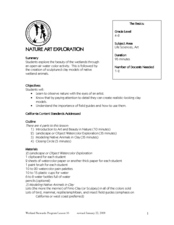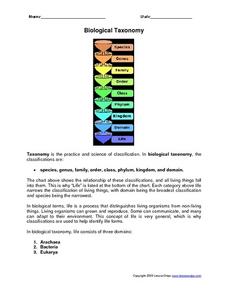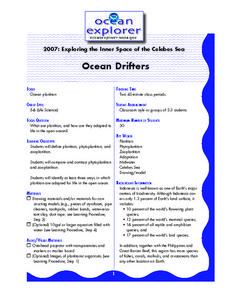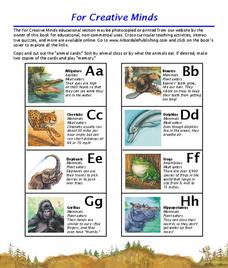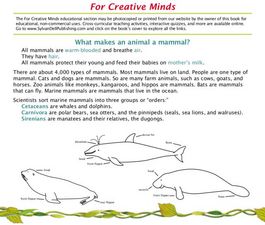Curated OER
Nature Art Exploration
Young scholars draw a nature landscape using watercolors. In this life science lesson, students share their personal experience on the beauty of nature. They create clay models of different native animals.
Curated OER
Comparing Two Turtles
Young scholars compare and contrast the various observable features of two different turtles. in groups, they complete a visual analysis of the sea turtle and tortoise. Using their observations, they complete Venn Diagram of the...
Curated OER
Types of Scientists
In this science learning exercise, students match each type of scientist listed in the left-had column to its correct description found in the right-hand column. There are 34 different scientists to match on the sheet.
Curated OER
Watchable Wildlife Checklist
In this wildlife worksheet, students will read over a list of 28 native animal species, their needs, and interesting characteristics. This list can be used as a checklist when out on a hike or in the school yard to identify common wildlife.
Curated OER
Biological Taxonomy
For this biology worksheet, students read about biological taxonomy. They then use the information they learned to answer the 13 questions on the worksheet. The answers are on the last page of the packet.
Curated OER
Radical Reptiles
In this reptiles learning exercise, learners read about reptiles and then answer 10 questions about what they just learned. The answers are on the last page.
Curated OER
"Sleep"
In this reading comprehension worksheet, students read a passage about sleep cycles. Students answer 11 multiple choice questions about the text.
Curated OER
Great Blobs of Jelly!
Learners explain how zoo-plankton have an impact on the global process. In this ocean zoo-plankton lesson plan students calculate carbon flux and plankton densities.
Curated OER
Ocean Drifters
Students define terms, and identify three ways in which plankton are adapted for life in the open ocean. In this ocean drift lesson students design a planktonic organism.
Curated OER
Do You Have the Key?
Students practice using a dichotomous key. In this classification lesson, students read an article about scientific exploration and identification of new species. They use a dichotomous key to identify objects and create their own key.
Curated OER
Outta Gas
Learners explore practical problems that are related to scuba diving. In this oxygen lesson students complete a lab activity.
Curated OER
Let's Get Specific
Students explore how different species thrive. In this speciation lesson students research and complete a lab activity.
Curated OER
Seeing Green Crossword Puzzle
In this seeing green activity worksheet, students use the 25 clues and word bank to identify the words needed to complete the crossword puzzle.
Curated OER
ABC Safari
Students study the animals and their alphabet letter. In this animal alphabet lesson, students associate the animals with their letter and learn facts about the animals. Students may use the cards to classify animals by groups or play a...
Curated OER
For Creative Minds: What Makes an Animal a Mammal?
Students read about categories of mammals and their features. Students then construct a marine animal, using given print outs in the lesson. Students then create adaptations for their mammal, using a web site reference for guidance.
Curated OER
Vertebrate Classification Challenge
Students determine which animals belong to the vertebrate phyla. In this classification instructional activity, students are given large papers with the names of the phyla of vertebrates. They must work together to place organisms...
Curated OER
Life Cycles in Action - Flip Book
Students create a flip book to depict animal and plant life cycles. In this life cycle lesson, students discuss life cycles. Students receive a plant or animal and pictures of its life cycle. Students color the pictures and order...
Curated OER
Reptile Round-UP
In this reptiles identification worksheet, 3rd graders match 7 reptile names with their pictures. Students must draw a line to show the name of each reptile shown in the pictures provided.
Curated OER
Learning Activities: What Color Am I?
Learners identify various species of anurans by their skin coloration. They describe how coloration contributes to survival.
Curated OER
From Polliwog to Frog
Learners examine how frogs change. In this life cycle lesson, students create a model to show how a frog changes throughout its life. Learners will show the process of frog metamorphosis, from polliwog to adult frog.
Curated OER
Animals Galore
Third graders use structural characteristics to sort and classify animals into groups.
Curated OER
Animal Classification
Young scholars classify animals. In this animal classification lesson, students identify characteristics from each of the 5 categories of vertebrates. Young scholars group animals by categories.
Curated OER
Change by Chance?
Sixth graders are able to see the role of chance in evolution. The activity is similar to the party game "gossip" or "telephone." Students start off with a drawing of an animal which changes as they pass their copies of the animal to...
Curated OER
Sorting Pond
Students practice balancing while learning the classifications of different animals
Other popular searches
- Reptiles and Amphibians
- Amphibians With Worksheets
- Fish and Amphibians
- Reptiles Amphibians
- Amphibians and Reptiles K 2
- Frogs and Amphibians
- Reptiles & Amphibians
- Animal Needs Amphibians
- Amphibians That Hibernate
- Amphibian Species
- Amazing Amphibians
- Amphibian Adaptations
